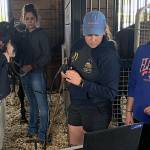Simple Saliva Test Identifies Horses with Gastric Ulcers

Veterinarians use gastroscopy to definitively diagnose equine gastric ulcer syndrome (EGUS). For squamous disease affecting the upper region of the stomach, lesions are graded on a scale from 0-4, where 0 indicates no lesions and 4 signifies extensive ulcerative lesions. In contrast, glandular disease affecting the lower region of the stomach is typically described based on the visual appearance of the lesions rather than using a numeric grading scale.
Treatment, regardless of the form of EGUS, relies on acid suppression through the administration of products designed to increase the pH of the stomach.
“KER Targeted Nutrition offers several products for horses at risk of digestive issues, including digestive buffers and ReSolvin EQ, a blend of polyunsaturated fatty acids shown to help promote gastric health in performance horses,” said Catherine Whitehouse, M.S., a nutrition advisor for Kentucky Equine Research.
Not only is gastroscopy used to diagnose EGUS, but it is also used repeatedly during the treatment period to determine response to therapy and to guide treatment cessation.
“Endoscopy is performed in the sedated, standing horse by a veterinarian and is considered a minimally invasive procedure. However, the fasting protocol prior to gastroscopy can be a concern to owners as well as provide logistical challenges. Thus, a saliva-based test may provide a more economic and less invasive approach to differentiating horses with and without EGUS,” explained Whitehouse.
In a recently published study, the value of saliva-based EGUS testing was explored. Two proteins, calprotectin and aldolase, were measured in the saliva of five different groups of horses: healthy horses (15); horses with squamous disease (25), horses with glandular disease (32), horses with both squamous and glandular disease (38); and horses with signs of EGUS but without compatible gastroscopic images. In this group, further diagnostic exams were given, including rectum exploration, transabdominal ultrasonography, intestinal biopsies, abdominocentesis or exploratory laparotomy (21).
Both the calprotectin and aldolase tests were already commercially available but had not been previously validated in horses.
In the study, both calprotectin and aldolase were significantly higher in horses with EGUS than in healthy horses. This included all the horses with squamous, glandular, or both forms of EGUS. There was no significant difference in protein levels between horses with squamous and glandular disease, and no difference between horses with EGUS and other gastrointestinal diseases.
“Calprotectin had a high ability to differentiate between healthy horses and those with EGUS. While aldolase was also able to differentiate between healthy horses and EGUS horses, it had a lower sensitivity and specificity than calprotectin, meaning there were more false positive and negative test results,” Whitehouse said.
*Muñoz-Prieto, A., M.D. Contreras-Aguilar, J.J. Cerón, et al. 2023. Changes in calprotectin (S100A8-A9) and aldolase in the saliva of horses with equine gastric ulcer syndrome. Animals (Basel) 13(8):1367.








